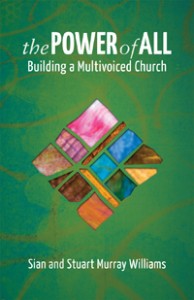 A few years ago Stuart Murray while promoting his book "The Naked Anabaptist" came to Elizabethtown College to speak and share. During that time he gave out a document called "Anabaptist Network Core Convictions". Number 5 of the Core Convictions is "Churches are called to be committed communities of discipleship and mission, places of friendship, mutual accountability and multivoiced worship." When I read that the term multivoiced worship jumped off the page at me and gave me words for what we had been attempting at Veritas. I wanted to know more.
A few years ago Stuart Murray while promoting his book "The Naked Anabaptist" came to Elizabethtown College to speak and share. During that time he gave out a document called "Anabaptist Network Core Convictions". Number 5 of the Core Convictions is "Churches are called to be committed communities of discipleship and mission, places of friendship, mutual accountability and multivoiced worship." When I read that the term multivoiced worship jumped off the page at me and gave me words for what we had been attempting at Veritas. I wanted to know more.
Jump forward to a few months ago when Stuart Murray Williams and his wife Sian released the book "The Power of All: Building a Multivoiced Church." I knew that I wanted to read it and that is when I was given the opportunity to review the book through Herald Press. So I want to thank Herald Press for the opportunity to review this book.
The question that the authors are seeking to answer is how can a New Testament model help empower and renew the church in today's post-Christian society? And they spend the next 180 pages unpacking what it means to be a multivoiced church. They unpack what it looks like in worship, in leadership, in discernment, and in discipleship.
One of the first things though that needed to be explained by the authors is what a multivoiced church actually is. They define a multivoiced church as, "an alternative to the dominant traditions in which large numbers of the Christian community are passive consumers instead of active participants. It replaces reliance on one person (variously designated as priest, vicar, minister, pastor, lead elder, or whatever) or a small group of people (elders, deacons, leadership team, church board, parochial church council or whatever) with an expectation that the whole community is gifted, called, empowered and expected to be involved in all aspects of church life."
This approach, the multivoiced approach, to church life, ministry, and mission is something that we at Veritas have been trying to live out on a weekly basis in our gatherings. We have sought to move away from passive spectators to active participants by having discussion following the message as well as dialogue around our weeks and how we have been a blessing in the world, what God is teaching us, and how we are doing life with other followers of Jesus. Multivoiced worship takes longer. There is no in and out in under an hour. And that might scare some people away, because they want to come to church on Sunday and get out and get on with their day. But we are committed to being multivoiced even if it takes longer (in terms of worship but also in terms of leadership, decision making, etc..)
There is a wealth of information in this book. There is a lot to chew on and think about. There is a lot of ideas and concepts to think about and dream about, and figure out how to make it a reality in our faith communities. Here are some of those things that I will be chewing on in the days to come:
"Most Christians are not engaged as participants in the mission of God and Churches are structured for passivity." - Quotes from Ed Stetzer.
"It is not a big step from there to the notion that we come to church to be entertained and inspired by specialist."
"Post-Christendom represents a much more serious challenge to the churches in Western societies than post-modernity, although this also opens up many fresh opportunities."
"In post-Christendom there will be fewer cultural supports for faith, many more lifestyle options, and numerous disincentives to discipleship. Passive attendance at weekly front-led worship events, however inspiring, and passive consumption of sermons, however well crated, will not do."
"Those who urge us to abandon, or at least de-emphasize, attractional forms of mission in favor of an incarnational approach rightly recognize that in post-Christendom the church is no longer at the center of society but on the margins, that 'going to church' is culturally alien and unattractive to most people in this society, and that the onus is increasingly on all of us to engage in dispersed forms of mission in teh various spheres of life in which we spend most of our time. Our calling is to live out, and when appropriate speak out, the gospel in our homes, neighborhoods, workplaces and social networks."
I could continue on in quoting various sections of the book that inspired, challenged, convicted, and made me think. There is just so much richness in this book. Anyone interested in moving from a passive spectator form to worship, church life, mission, and leadership should read this book. Anyone interested in post-Christendom forms of church, mission, discipleship, and leadership should read this book. Anyone interested in missional forms of church, mission, discipleship and leadership should read this book. I can't recommend this book any stronger. It was a privilege to read this book and I will be continually referring to it and using it to help our community become a multivoiced community.
Thanks to Herald Press for the opportunity to review this book.
